
Bolivia
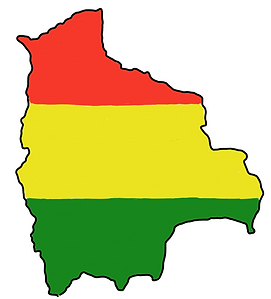
Fact File
Major cities: Sucre, La Paz, Santa Cruz de la Sierra, Cochabamba, El Alto, Oruro, Potosí
Currency: Boliviano (BOB) Bs
Population: 11.37 million (2024 census)
Official language: Spanish (castellano) - Quechua, Aymara (among others) are recognised for indigenous groups - a total of 37 official languages
Demonym in Spanish: boliviano
Image ©LanguagesonaPlate
Overview:
Bolivia, often thought of as an Andean nation, is in fact more Amazonian in landmass, though most of its population lives in the highlands. This dual geography, spanning the towering Andes and the vast lowland forests, gives the country a striking diversity of landscapes, cultures, and traditions. Once part of the Viceroyalty of Peru, Bolivia’s colonial past left an enduring legacy, with independence achieved in 1825 after the wars led by Simón Bolívar and Antonio José de Sucre.
Unusually, Bolivia is considered to have two capitals: Sucre, the constitutional capital; and La Paz, the seat of government and administration. Its national story has also been shaped by loss: most notably the War of the Pacific (1879–1884), in which Bolivia was defeated by Chile and famously lost its coastline, leaving the country landlocked. This sense of dispossession continues to influence Bolivian identity and politics today.
Sucre
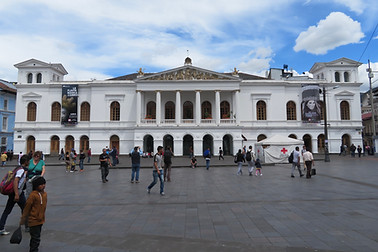
Image ©Highbury Nomad
Sucre
Sucre, often called the “White City” (La Ciudad Blanca), is Bolivia’s constitutional capital and one of its most historic urban centres. Founded in the 16th century by Spanish colonisers, its elegant whitewashed buildings, baroque churches, and cobblestone streets reflect the wealth generated from nearby silver mines in Potosí, which once made the region one of the richest in the Spanish Empire.
Historically, Sucre played a pivotal role in Bolivia’s independence. It was here, in 1825, that leaders declared the foundation of the Republic of Bolivia after the wars of liberation led by Simón Bolívar and Antonio José de Sucre. The city’s Casa de la Libertad, where the declaration was signed, remains a national symbol and one of Bolivia’s most important monuments.
As the seat of the Supreme Court, Sucre continues to embody its role as Bolivia’s constitutional capital, even though political power shifted to La Paz in the late 19th century. Its preserved colonial architecture, university heritage, and strong links to the country’s legal and revolutionary history give Sucre a distinctive identity as both a cultural and intellectual centre.
Today, Sucre is recognised as a UNESCO World Heritage Site for its outstanding colonial architecture and historical significance.
La Paz
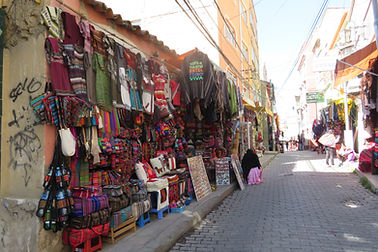
La Paz
La Paz, Bolivia’s administrative capital, lies in a dramatic Andean valley at around 3,600 metres above sea level, overlooked by the snow-capped peak of Illimani. Its unique setting makes it one of the highest capitals in the world
Image ©Highbury Nomad
Historically, La Paz rose to prominence in the late 19th century, when political power shifted from Sucre after civil conflict. Its growth was tied to trade, mining wealth, and its strategic location as a hub connecting the highlands with other regions of Bolivia. Since then, La Paz has developed into the political and economic heart of the nation, housing the executive and legislative branches of government.
The city is also a meeting point of Bolivia’s diverse cultures. At the famous Witches’ Market (Mercado de las Brujas), Aymara traditions are alive in stalls that sell herbs, charms, and ritual offerings, including dried llama foetuses, which are buried under the foundations of new buildings to bring good fortune. These practices highlight the fusion of pre-Columbian spirituality with Catholic influences, a syncretism that remains central to Bolivia’s cultural identity.
In recent decades, La Paz has been at the centre of Bolivia’s turbulent political landscape. The rise of Evo Morales, the country’s first indigenous president, marked a historic shift, giving visibility and political power to Bolivia’s Aymara and Quechua populations. His long presidency brought major social changes, but also sparked controversy and division, particularly over contested re-elections and accusations of authoritarianism.
The city’s location also underlines this connection between politics and heritage. Close to the ancient ruins of Tiwanaku, one of the most important ceremonial centres of the pre-Columbian Andes, La Paz sits within a landscape deeply tied to indigenous identity and history. The surrounding region is also home to dramatic modern landmarks such as the infamous Death Road cycling track.
Potosí
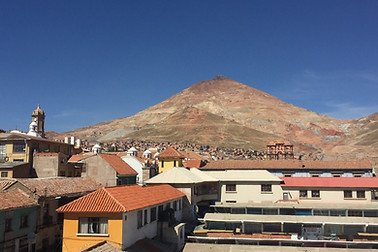
Image ©Highbury Nomad
Potosí
Potosí, located high in the Bolivian Andes at over 4,000 metres above sea level, is one of the most historically significant mining cities in the world. Founded in 1545 after the discovery of silver in the nearby Cerro Rico (“Rich Mountain”), it rapidly became one of the wealthiest and most populous cities of the Spanish Empire.
The scale of its output was so vast that Potosí’s silver fuelled European economies for centuries and even influenced global symbols: the intertwining of the letters “S” and “I” the identifier for silver from Potosí (the city's last 2 letters), is widely believed to have evolved into the modern dollar sign ($).
The wealth of Potosí came at a devastating human cost. Indigenous labourers and enslaved Africans were forced into the mines under brutal conditions, with millions believed to have died in Cerro Rico over the colonial period. The Guardian even reported that some historians estimate up to 8 million people have died in the Cerro Rico since the 16th century. This legacy of exploitation remains etched into the city’s identity and its UNESCO World Heritage designation highlights both its architectural beauty and its tragic past.
Mining continues in Potosí to this day, often carried out under dangerous and illegal conditions. Cerro Rico’s tunnels are worked largely by cooperative miners using rudimentary methods, with few safety measures in place. Before entering the mines, it is customary for workers to make offerings to El Tío, a devil-like figure stationed at the entrances, who is believed to guard the mountain and must be appeased with coca leaves, alcohol, and cigarettes to ensure protection underground.
Tiwanaku

Image ©Highbury Nomad
Tiwanaku
Tiwanaku, located near Lake Titicaca in western Bolivia, is one of the most important pre-Columbian archaeological sites in South America. Once the centre of a civilisation that flourished between roughly 500 and 1000 CE, it was a ceremonial and political hub whose influence spread across the Andes. The monumental stonework of Tiwanaku has made it a UNESCO World Heritage Site and a key symbol of Bolivia’s indigenous heritage.
Among its most iconic monuments is the Sun Gate (Puerta del Sol), carved from a single block of stone and decorated with images linked to Andean cosmology. In the 19th century, foreign expeditions attempted to move the gate, and British archaeologists damaged it irreparably when they reassembled it incorrectly. This interference left lasting scars on the monument, which remains central to Andean identity despite its altered state.
Near Tiwananku lies another ancient site, Pumapunku, which houses enormous stone blocks cut with extraordinary precision. Its unusual construction and precision has made it a favourite subject for theories like “ancient aliens.”
Another significant feature of the site is its tall anthropomorphic monoliths, including one that for decades stood outside in central La Paz, where it was frequently surrounded by large crowds at public events. This statue has since been returned to Tiwanaku to ensure its protection.
Cochabamba
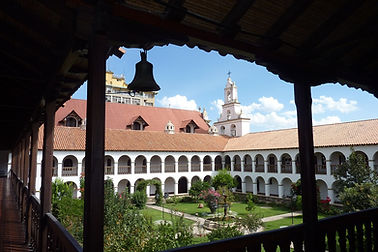
Cochabamba
Cochabamba, located in central Bolivia, has historically been a key crossroads between the Andean highlands and the lowland valleys. Its fertile surroundings made it one of the country’s main agricultural centres, while its position in the middle of the nation has long given it strategic importance for trade, politics, and culture.
Image ©jimcintosh
The city became internationally known in the year 2000 during the Cochabamba Water Wars. At that time, control of the city’s water supply was privatised and handed to a foreign company, leading to steep price rises that made access to water unaffordable for many residents. Massive protests broke out, uniting workers, students, farmers, and indigenous groups.
After weeks of demonstrations and clashes with security forces, the government was forced to cancel the privatisation contract, making Cochabamba a global symbol of resistance against the commodification of basic resources. The events were later dramatised in the 2010 Spanish film También la lluvia (Even the Rain), which highlighted the parallels between colonial exploitation and modern struggles for justice.
The Water Wars not only exposed deep inequalities in Bolivia but also helped galvanise broader political movements, paving the way for the rise of leaders such as Evo Morales. As a curiosity, the city's most recognisable landmark is the Cristo de la Concordia, a towering statue of Christ that is even larger than Rio de Janeiro’s Christ the Redeemer.
Copacabana
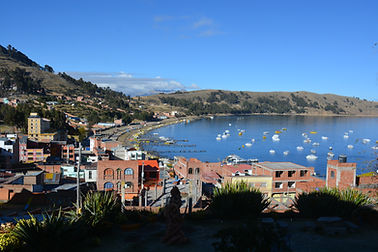
Copacabana
Copacabana, on the Bolivian side of Lake Titicaca, is one of the country's most important religious and cultural centres. The town has deep pre-Columbian roots, as the lake itself was sacred to both the Tiwanaku and later the Inca, who believed it to be the birthplace of the sun god Inti.
Image ©Highbury Nomad
Despite its deep connection to indigenous religions, the town also houses Bolivia’s patron saint, the Virgen of Copacabana. The saint’s image attracts thousands of pilgrims each year and has inspired an important annual festival. Moreover, the town’s proximity to sacred sites of the Andean world highlights the active syncretism in modern Bolivian society, where Catholic devotion and indigenous spirituality continue to coexist. Copacabana is also a gateway to the nearby Isla del Sol, one of the most significant sites in Inca mythology.
Uyuni
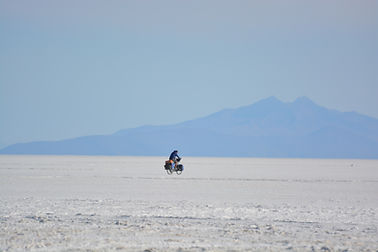
Uyuni
Uyuni, a town in southwest Bolivia, is best known as the gateway to the Salar de Uyuni, the largest salt flat in the world. Stretching over 10,000 square kilometres, the salar was formed from prehistoric lakes that dried up. Its beauty has made it one of Bolivia’s most recognisable landscapes.
Image ©Highbury Nomad
The salar has long been important to the local economy, with salt having been harvested there for centuries. However, recently it's been discovered that one of the world's largest lithium reserves lies below the salt crust, an estimated 9 million metric tonnes. In theory, the future of the salt flat could be in jeopardy as the economic value of the lithium reserves could see Bolivia rise from long-standing poverty to economic prominence as lithium is key in modern technology development.
In addition to the economic value of the natural resources in the salt flats, the Salar de Uyuni has become one of the world's most iconic natural landscapes. It is particularly recognisable when the flats flood, turning the surface into a reflective mirror. As a result of its unique natural beauty, the site has been used in car commercials and even in films such as Star Wars: The Last Jedi (2017).
Train Graveyard
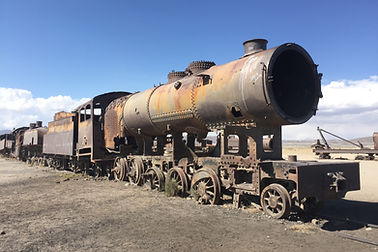
Cementerio de Trenes
Train Graveyard (Cementerio de Trenes), near Uyuni sits on the windswept outskirts of Bolivia’s salt-flat, offering a haunting glimpse into the country’s industrial past. The site houses around one hundred abandoned and rusting steam locomotives and carriages, discarded in the 1940s after the collapse of the mining boom.
Image ©Highbury Nomad
These relics were largely imported from Britain during the late 19th and early 20th centuries, part of an ambitious railway project aimed at linking Bolivia’s mineral-rich highlands with Pacific ports, most notably Antofagasta in Chile.
Beyond its industrial legacy, the train graveyard has taken on a new cultural resonance. The rusting silhouettes against the high-altitude desert create an almost post-apocalyptic landscape that has become a magnet for photographers and visitors, often included in tours of the Salar de Uyuni.
Local legend also adds to its mystique, with stories linking one of the abandoned engines to the final days of the outlaws Butch Cassidy and the Sundance Kid, who are said to have fled into Bolivia after their exploits in the American West.
Isla del Sol

Isla del Sol
Isla del Sol (Sun Island), along with Isla de la Luna (Moon Island), located on Bolivia’s side of Lake Titicaca, are among the country’s most important cultural and historical sites. Long considered sacred, the two islands occupy a central place in Andean tradition and remain some of the most evocative landscapes in the region.
Image ©Highbury Nomad
They were closely tied to the Tiwanaku civilisation and later to the Inca Empire, which regarded the islands as the mythical birthplace of the sun god, Inti, and the moon goddess, Mama Killa. This made them vital centres of religious life, shaping beliefs that spread across the Andes.
Today, both islands attract visitors from around the world. Tourists are drawn by their panoramic views of Lake Titicaca, the ruins that recall their pre-Columbian importance, and the chance to experience communities that still maintain traditional ways of life.